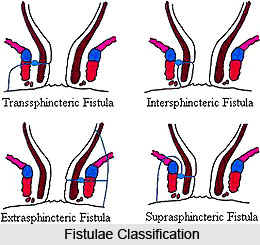 Fistula is a form of bodily cavity that burrows under the skin or mucous membrane and has an opening at both ends and is a common anorectal disorder. Several types of fistulas can be found in human beings. The umbilical fistula, the vesico vaginal fistula, the anal fistula, etc. are the major types of fistulas. The other common fistulas include the intersphincteric fistula, transphincteric fistula, suprasphincteric fistula, extrasphincteric fistula, etc.
Fistula is a form of bodily cavity that burrows under the skin or mucous membrane and has an opening at both ends and is a common anorectal disorder. Several types of fistulas can be found in human beings. The umbilical fistula, the vesico vaginal fistula, the anal fistula, etc. are the major types of fistulas. The other common fistulas include the intersphincteric fistula, transphincteric fistula, suprasphincteric fistula, extrasphincteric fistula, etc.
The umbilical fistula is an abnormal passage from the umbilicus to the intestine. It also communicates with the gut at the umbilicus to the remnant of the canal in the median umbilical ligament that connects the fetal bladder with the allantois. The vesico vaginal fistula (VVF) is another major type of fistula. It often has a profound effect on the patient`s emotional well-being, in addition to the medical abnormalities. It is often caused by childbirth.
The anal fistula is considered the most common type of fistula. It usually forms near the anus and may or may not have connection with the rectum. It originates from the anal glands that are located between the two layers of the anal sphincters. The glands drain into the anal canal and an abscess can form if the outlet of these glands becomes blocked. This abscess which can eventually point to the skin surface and the tract formed by this process is the fistula. The anal fistula is characterised by constant oozing of pus and is often accompanied by pain. In case of anal fistula; the faeces enter the opening and make the healing difficult. The anal fistulas usually do not cause harm and often do not hurt as well. However, they can irritate a lot because of the pus-drain.
Another common type of fistula is the intersphincteric fistula. In this type, the tract begins in between the internal and external sphincter muscles and then opens very close to the opening of anus. The transphincteric fistula is a type of fistula in which the tract begins in the space between the internal and external sphincter muscles or in the space behind the anus. After its formation, this fistula crosses the external sphincter and opens an inch or two outside the opening of anus. This type of fistula can wrap around the body with its external openings on both sides of the anus. This is also sometimes referred as a horseshoe fistula.
There is another type of fistula named suprasphincteric fistula. In this fistula, the tract begins in the space between the internal and external sphincter muscles and then turns upward to a point above the puborectal muscle. After crossing this muscle, this fistula extends downward between the puborectal and levator ani muscle. The suprasphincteric fistula ultimately opens an inch or two outside the anus. Another type of fistula is the extrasphincteric fistula. The starting point of the tract is different here from the other types of fistulas. Here, the tract begins at the rectum or sigmoid colon and then extends downward. The tract passes through the levator ani muscle and then opens around the anus. The main causes of the extrasphincteric fistulas include an appendiceal abscess, the diverticular abscess or the Crohn`s disease.
The above mentioned types of fistulas are most common among human beings. However, there are some other types that include the enterocutaneous fistula, the enteroenteric or enterocolic fistula; the enterovesicular fistula; etc. Knowing the right type of fistula a person is suffering from helps a lot in choosing the exact treatment method.




